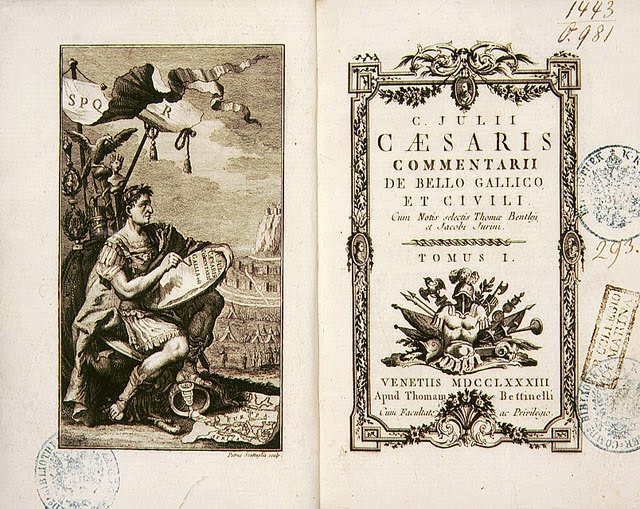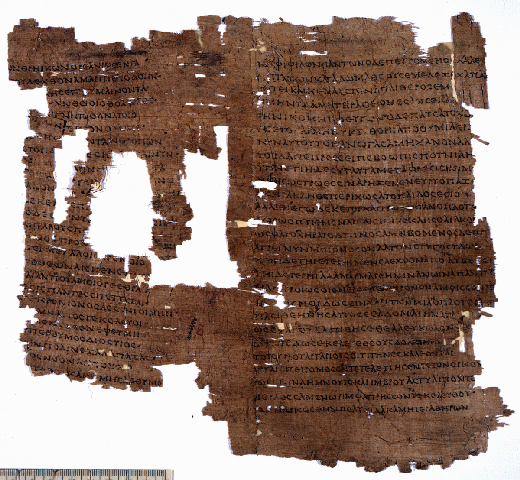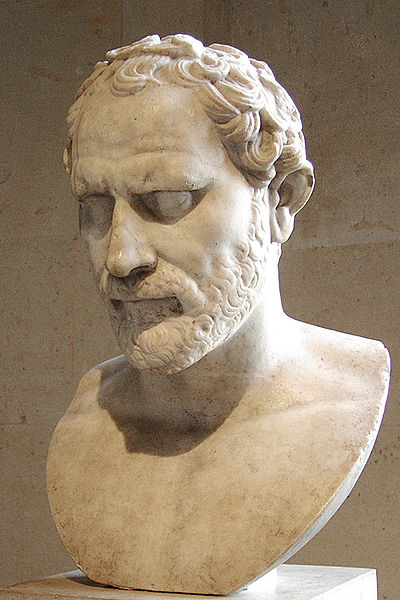 1. Женска статуя от Оксер
1. Женска статуя от ОксерThis statuette of a woman was purchased in 1895 by the manager of the theater at Auxerre, who used it as decoration for an operetta. It was then given to the city's museum, where it was spotted by Maxime Collignon in 1907. Two years later, the Lady of Auxerre entered the Louvre collection, in exchange for a painting by Henri-Joseph Harpignies (1819-1916). Almost immediately it was recognized as the finest example of the Daedalic style-a concept invented in the early twentieth century to describe sculpture from the seventh century BC. The name is taken from the mythical sculptor Daedalus, who is credited with the creation of the first Greek statues. The Lady of Auxerre stands upright, her left arm by her side, her right folded across her chest, in the strict frontality that is characteristic of the Daedalic. She is clothed in a sheath dress held in at the waist by a large belt; on her shoulders is a cape. She has a soft smile, and her U-shaped face is framed by thick hair arranged in beaded plaits, in the manner of a thick Egyptian wig. Incising outlines her clothing and accessories, which were once highlighted in red, black, and blue polychrome, lessening the contrast between the head and the bust.
Since we know nothing about the context in which the statuette was discovered, it is difficult to identify the person depicted or to determine the meaning of the gesture of the right hand. Some think that this is the image of a goddess, considering the many terracotta figurines of Middle Eastern divinities (Astarte in particular) that highlight their sexual attributes. Others see this statue as a simple mortal, the servant of some fertility cult or perhaps the dedicator herself making a gesture of prayer.
This work is a testament to the intense artistic activity that took place in the eastern regions of the Mediterranean basin during the Orientalizing period. Techniques and decorative repertories originating in Egypt and the Near East were spread by Greek artisans who blended these models with their own traditions. The Auxerre statuette was created in Crete in the seventh century, around 640-620 BC. The work is assigned to Crete because of the type of limestone used as well as similarities of the young woman's costume, gesture, and face with works in bronze, limestone, and clay that have been discovered on the island. Comparison with funerary material excavated at Eleutherna, in northern Crete, suggests that the Lady of Auxerre was found in this necropolis in the late nineteenth century.
 2. Клеобис и Битон
2. Клеобис и БитонStatues of Kleobis and Biton (identified by inscriptions on the base) dedicated to Delphi by the city of Argos, signed by [Poly?]medes of Argos. Marble, Peloponnesian artwork (?), ca. 580 BC. H. 1.97 m., after restoration. Archaeological Museum of Delphi.
 3. Сфинкс от Наксос
3. Сфинкс от НаксосNaxian Sphinx, Delphi, c. 560 BC
(2.32m; Ionic column ~10m) Delphi Archaeological Museum
 4. Кора от Акропола
4. Кора от АкрополаKore, Acropolis, Athens, c. 520-510 BC (0.93m). Acropolis Museum
ІІ. Класическа
 1. Колесничарят от Делфи
1. Колесничарят от ДелфиThe Charioteer of Delphi, also known as Heniokhos (the rein-holder), is one of the best-known statues surviving from Ancient Greece, and is considered one of the finest examples of ancient bronze statues. The life-size statue of a chariot driver was found in 1896 at the Sanctuary of Apollo in Delphi, well, it is now in the Delphi Archaeological Museum.
The statue was erected at Delphi in 474 BC, to commemorate the victory of a chariot team in the Pythian Games, which were held at Delphi every four years in honor of Pythean Apollo. It was originally part of a larger group of statuary, including the chariot, four (possibly six) horses and two grooms. Some fragments of the horses were found with the statue. When intact, it must have been one of the most imposing works of statuary in the world.
Stylistically, the Charioteer is classed as "Early Classical" or "Severe" (see Greek art). The statue is more naturalistic than the kouroi of the Archaic period, but the pose is still very rigid when compared with later works of the Classical period. One departure from the Archaic style is that the head is inclined slightly to one side. The naturalistic rendering of his feet was greatly admired in ancient times. This sculpture displays several advancements on Archaic sculpting style - the introverted expression does away with the old 'Archaic smile' and he would not have been clothed in the Archaic period. His robes are a testament to the talent of the sculptor. There would have been a chariot to cover most of the waist and below, so not much interested is added to his robes, however.
 2. Атина с копие
2. Атина с копиеAthena wearing the Doric peplos, barefoot, wearing her helmet, and her spear, with its point facing down. She's staring at a stele in front of her, pensive. The stele might be the mark of her temple, or a public marker, or tomb. The goddess looks like a young girl, but without carefreeness of youth, because she is serious, grave, a characteristic of the "Austere Movement" in art. [relief of pensive Athena, 460 B.C., Athens Acropolis Museum]
 3. Мирон, "Дискобол"
3. Мирон, "Дискобол"he Discobolus of Myron ("discus thrower" Greek Δισκοβόλος, "Diskobolos") is a famous Roman marble copy of a lost Greek bronze original, completed during the zenith of the classical period between 460-450 BC. A discus thrower is depicted about to release his throw. The moment captured in the statue is an example of rhythmos, harmony and balance. Myron is often credited as being the first sculpture to master this style. Naturally, as always in Greek athletics, the Discobolus is completely nude. His pose is said to be unnatural to a human, and today considered a rather inefficient way to throw the discus. Also there is very little emotion shown in the discus thrower's face. The other trademark of Myron depicted in this sculpture is how well the body is proportioned, the symmetria. The Diskobolus Palombara stands at 1.55 meters tall (5 feet, 1 inch).
 4. Statue of Diadoumenos (youth tying a fillet around his head), ca. 69–96 A.D., Roman copy of a Greek bronze statue by Polykleitos, ca. 430 B.C
4. Statue of Diadoumenos (youth tying a fillet around his head), ca. 69–96 A.D., Roman copy of a Greek bronze statue by Polykleitos, ca. 430 B.Chttp://cobalt.rocky.edu/~moakm/archaicsculpt.htm
http://smarthistory.org/site/classical-antiquity











No comments:
Post a Comment